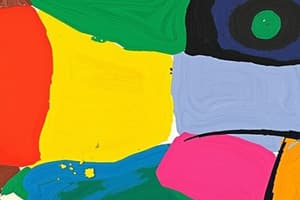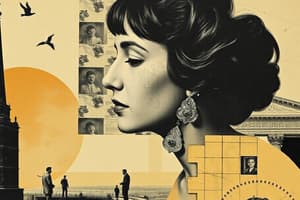Podcast
Questions and Answers
What are the two distinct fields in understanding art?
What are the two distinct fields in understanding art?
- Art History and Modern Art
- Art History and Art Critique
- Art History and Art Appreciation (correct)
- Art Appreciation and Art Theory
Art is only universal and does not reflect cultural beliefs.
Art is only universal and does not reflect cultural beliefs.
False (B)
Name one function of art.
Name one function of art.
Physical Function, Social Function, or Personal Function
Which of the following is an example of 2D visual art?
Which of the following is an example of 2D visual art?
What does 3D visual art utilize?
What does 3D visual art utilize?
Plato viewed art as ______ because it represents imperfect copies of ideal forms.
Plato viewed art as ______ because it represents imperfect copies of ideal forms.
Match the following art forms with their characteristics:
Match the following art forms with their characteristics:
What concept refers to the size relationships between different elements in a composition?
What concept refers to the size relationships between different elements in a composition?
Which painting is an example of asymmetrical balance?
Which painting is an example of asymmetrical balance?
Which element is primarily used to create a focal point in a composition?
Which element is primarily used to create a focal point in a composition?
What does contrast achieve in a visual composition?
What does contrast achieve in a visual composition?
Which work of art illustrates the concept of ideal human proportions?
Which work of art illustrates the concept of ideal human proportions?
What element refers to the repeated arrangement of shapes, lines, or colors?
What element refers to the repeated arrangement of shapes, lines, or colors?
Which term describes the use of different design elements to maintain viewer interest?
Which term describes the use of different design elements to maintain viewer interest?
What type of balance shows unequal distribution yet still achieves harmony?
What type of balance shows unequal distribution yet still achieves harmony?
What does the Rule of Thirds involve in composition?
What does the Rule of Thirds involve in composition?
What are the overlapping areas of the circles in the Rule of Thirds referred to as?
What are the overlapping areas of the circles in the Rule of Thirds referred to as?
Why is it generally better to avoid filling all four focal points in a composition?
Why is it generally better to avoid filling all four focal points in a composition?
In Peploe's 'Still Life with Coffee Pot', where does the horizontal line of the table edge run?
In Peploe's 'Still Life with Coffee Pot', where does the horizontal line of the table edge run?
In the context of the Rule of Thirds, where is the reflected light on the teapot located in Peploe's painting?
In the context of the Rule of Thirds, where is the reflected light on the teapot located in Peploe's painting?
What is the primary goal of using the Rule of Thirds in art composition?
What is the primary goal of using the Rule of Thirds in art composition?
Which of the following elements is typically emphasized using the Rule of Thirds?
Which of the following elements is typically emphasized using the Rule of Thirds?
What is not a characteristic of artworks that employ the Rule of Thirds?
What is not a characteristic of artworks that employ the Rule of Thirds?
What is the primary function of line in artwork?
What is the primary function of line in artwork?
How does value contribute to the perception of objects in art?
How does value contribute to the perception of objects in art?
What role does color play in a work of art?
What role does color play in a work of art?
Which element of art adds depth and realism by representing three-dimensional objects?
Which element of art adds depth and realism by representing three-dimensional objects?
What does transcreation in arts primarily involve?
What does transcreation in arts primarily involve?
Which of the following artists was influenced by Japanese woodblock prints?
Which of the following artists was influenced by Japanese woodblock prints?
Which artistic principle emphasizes the harmony of all elements in a composition?
Which artistic principle emphasizes the harmony of all elements in a composition?
What is the significance of texture in artwork?
What is the significance of texture in artwork?
Which process involves changing the characteristics of the original artwork, such as its shape or color?
Which process involves changing the characteristics of the original artwork, such as its shape or color?
Which principle of art addresses the organization and relationship among different art elements?
Which principle of art addresses the organization and relationship among different art elements?
What does transcreation involve when adapting an artwork?
What does transcreation involve when adapting an artwork?
In Van Gogh's reinterpretation, how did he approach Hiroshige's woodblock print in "Bridge in the Rain (after Hiroshige)?"
In Van Gogh's reinterpretation, how did he approach Hiroshige's woodblock print in "Bridge in the Rain (after Hiroshige)?"
What is demonstrated when Van Gogh uses Keisai Eisen's print in 'The Courtesan (after Eisen)'?
What is demonstrated when Van Gogh uses Keisai Eisen's print in 'The Courtesan (after Eisen)'?
What can a 3D digital model of Salvador Dalí's 'The Persistence of Memory' be seen as an example of?
What can a 3D digital model of Salvador Dalí's 'The Persistence of Memory' be seen as an example of?
Which aspect of Van Gogh's style is notably highlighted in his reinterpretations?
Which aspect of Van Gogh's style is notably highlighted in his reinterpretations?
What term best describes the practice of reworking an existing design to fit a contemporary vision?
What term best describes the practice of reworking an existing design to fit a contemporary vision?
Flashcards are hidden until you start studying
Study Notes
Assumptions and Nature of Arts: Creativity, Imagination
- Art history and art appreciation are distinct fields; history examines chronological development, while appreciation focuses on subjective experiences.
- Art is viewed as universal, conveying emotions and ideas that resonate across cultures and reflect shared human experiences like love and struggle.
- Cultural context is essential for interpreting art, as it mirrors beliefs, values, and traditions unique to different societies.
- Art must be experienced emotionally, engaging audiences in active interpretation and stimulating the senses.
Visual Art
- Visual Art employs colors, shapes, lines, and textures to evoke emotions and perceptions, reshaping worldviews through creativity.
2D Visual Arts
- Painting: Utilizes pigments on surfaces to depict scenes, emotions, or concepts.
- Drawing: Involves creating images with tools like pencil and charcoal, across realistic to abstract styles.
- Printmaking: Employs techniques like etching and woodcut to reproduce artwork.
3D Visual Arts
- Sculpture: Involves transforming substances like stone or clay into three-dimensional figures.
- Architecture: The art of designing and constructing buildings and structures.
- Installation Art: Comprising large-scale works intended for specific locations, using diverse materials.
Functions of Art
- Physical Function: Art has tangible value, such as a chair that is both functional and artistically designed.
- Social Function: Art addresses public perspectives, like murals that celebrate culture and foster community dialogue.
- Personal Function: Art serves as a form of self-expression, as exemplified by self-portraits conveying personal identity and emotions.
Basic Philosophical Perspectives
- Art as Imitation: Plato argued that art merely imitates ideal forms and can distract from truth and reason, suggesting restrictions on it to preserve understanding of reality.
- Art as Representation: Aristotle viewed art as a means to explore different realities and uncover philosophical truths, acknowledging its value in understanding various possibilities.
Elements of Art
- The elements of art serve as the fundamental building blocks for creating artwork.
- Line: Provides structure and guides the viewer’s eye while conveying emotion or movement.
- Shape: Forms the basic components of a composition, organizing elements and creating patterns.
- Color: Influences mood, expresses emotions, and highlights focal points; can convey symbolism.
- Space: Establishes relationships between objects, offering depth, perspective, and a sense of openness.
- Texture: Enhances the tactile quality of artwork, making it visually and physically engaging.
- Value: Represents contrasts between light and dark, adding depth and indicating solidity.
- Form: Represents three-dimensional objects, contributing to the depth and realism of artwork.
Transcreation in Arts
- Transcreation involves adapting creative works to new cultural contexts while preserving the original's essence.
- Vincent Van Gogh's works were significantly influenced by Japanese art, showcasing his unique color and style adaptations.
- "The Courtesan (after Eisen)" reflects Van Gogh's fascination with Japanese prints.
- "Bridge in the Rain (after Hiroshige)" showcases his reinterpretation of the original Japanese print through vivid, energetic brushwork.
- Influential artworks like Rodin's "The Thinker" inspired modern sculpture adaptations by various artists.
Factors Influencing Transcreation
- Distortion: Changing characteristics of an original piece. Example: Van Gogh's changes in "Bridge in the Rain," resulting in vivid and dramatic contrasts.
- Transformation: Adapting the medium or context. Example: Dalí's "The Persistence of Memory" could be reimagined as a 3D digital model.
- Appropriation: Using existing work elements to create something new. Example: Van Gogh's reinterpretation of Eisen's courtesan showcases personal and contemporary artistic expression.
Principles of Art
- Unity: Ensures all elements work together cohesively; example: Botticelli's "The Birth of Venus."
- Balance: Distribution of visual weight can be symmetrical, asymmetrical, or radial; example: Van Gogh's "The Starry Night."
- Emphasis: Highlights focal points through contrast, size, or placement; example: Dalí's "The Persistence of Memory."
- Contrast: Enhances visual interest through noticeable differences in elements; example: Kandinsky's "Composition VIII."
- Proportion: Relates the size of elements to maintain harmony; example: da Vinci's "Vitruvian Man."
- Pattern: Arrangement of repeated elements creates rhythm; example: Hokusai's "The Great Wave Off Kanagawa."
- Variety: Uses diverse elements to engage the viewer; example: Warhol's "Campbell’s Soup Cans."
Rule of Thirds
- Involves dividing an image into thirds both horizontally and vertically, creating focal points.
- Recommended approach is to emphasize select focal points instead of all four.
- Samuel Peploe's "Still Life with Coffee Pot" demonstrates the Rule of Thirds effectively through its composition and arrangement.
Studying That Suits You
Use AI to generate personalized quizzes and flashcards to suit your learning preferences.




